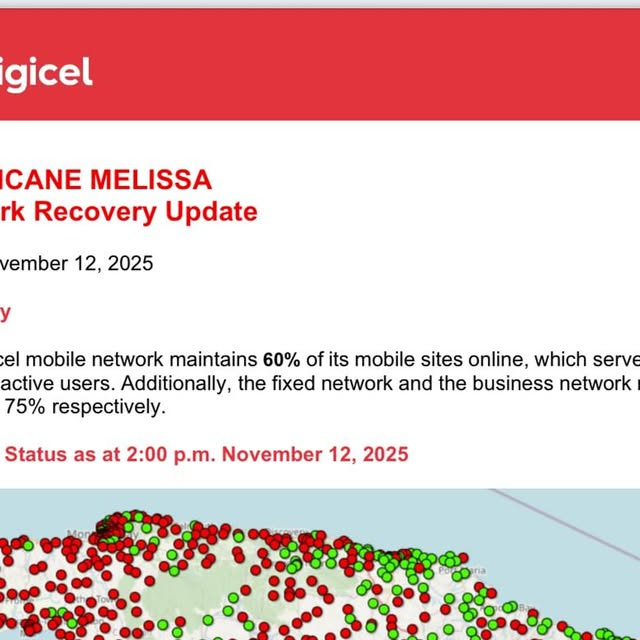Jamaica Is Fighting to Rebuild While Entire Towns Are Still Cut Off
Over two weeks after Hurricane Melissa hit, Jamaicans are still recovering from the storm.
The confirmed death count has now gone up to 45 people, according to authorities. About 15 other people are still missing. The death toll is expected to rise as authorities still do not have access to two towns in the country for them to assess damages.
Steadily, the Caribbean island has been restoring services. On Tuesday, the president and CEO of Jamaica’s power company, Hugh Grant, announced that power was restored to over 60% of Jamaica, including the international airport in Montego Bay.
According to the Jamaica Observer, the island has steadily supported flights between the nation and other countries, recording over 1,000 flights in 13 days. Cell service has been made available to 50% of customers and over 70% of people now have water, according to CBC.
Despite the gains made in recovering from Hurricane Melissa, many are still left without a home. Over 30,000 homes have been demolished as a result of the storm, displacing everyone in the households. Approximately 88 emergency shelters across nine parishes in Jamaica, particularly in western Jamaica, are open to house displaced families. As of now, a reported 1,100 people are still living in these shelters.
The number of people in the shelters has reportedly gone down. According to the United Nations Office for the Coordination of Humanitarian Affairs, at the height of the storm recovery, 25,000 people were in shelters. The number might have decreased from this initial rate, but the United Nations acknowledged that people have begun leaving the shelters due to limited access to adequate relief from the storm. Streets are also still debris-ridden, with three dozen roadways blocked by fallen debris. Road access is a challenge, particularly in regions such as Black River and Negril.
Hospital workers are also reportedly still spread thin, given the amount of help they can provide. With the arrival of the storm, health facilities and other health infrastructure were all affected, reporting damage of their own.
Although health care workers continued to provide support throughout the storm, hospitals still reportedly record increasingly higher emergency caseloads, lack of access to supplies and other unstable utilities. Health workers from the Spanish Emergency Medical Team, alongside the European Union, Pan American Health Organization and the Ministry of Health & Wellness, have publicly announced their arrival in Jamaica to assist with the treatment of civilians.
As they continue their recovery efforts, reports from the Jamaica Observer confirm that small businesses are also struggling, in large part due to agricultural issues. The Minister of Agriculture, Floyd Green, estimates that more than $29.5 billion in monetary value has been lost in agriculture. This comes as over 41,000 hectares of farmland have reportedly been affected by Hurricane Melissa, disrupting the farmland of more than 70,000 farmers. Over 1.2 million animals, including poultry and cattle, have also been lost.
Meanwhile, in Haiti, over 40 individuals lost their lives due to Hurricane Melissa. U.N. efforts have ramped up as the country continues to struggle with bouncing back following the arrival of the storm. Hygiene kits were distributed to citizens and electricity was restored to help with vaccine refrigeration as well as to provide support in schools.
Areas in Southern Haiti are being prioritized as regions such as Petite Goave struggled the most with recovery efforts following Hurricane Melissa. Per the UN, 15-food day rations have been provided to over 40,000 citizens as the UN Humanitarian Air Service has been deployed to add five new access points for distribution amongst isolated regions. Cuba, which was hit less hard than Jamaica, is also reportedly left with increasing rates of food insecurity and food loss due to the lack of refrigeration and inaccessibility to electricity.
Several recovery efforts are being affected by overlapping disasters. Per the Weather Channel, Jamaica alone was still recovering from Hurricane Maria, COVID-19 and Hurricane Beryl. The island was approximately two years into a 7-10-year recovery from Hurricane Maria and had just begun recovery from Hurricane Beryl.
Numerous organizations, including the U.N. and UNICEF, have announced an increase of support for Jamaica, Haiti and Cuba. The U.S. State Department also announced last week that $24 million will be sent in assistance, with $12 million devoted to Jamaica, $8.5 million for Haiti, $3 million for Cuba and $500,000 for the Bahamas.
Alongside the United Nations World Food Program, the State Department has already reportedly sent 5,000 family food packs to Jamaica. Each pack approximately feeds a family of four.




